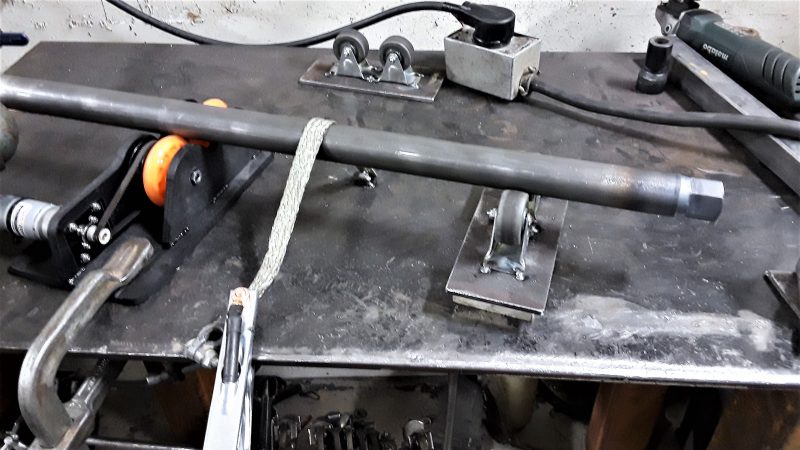You can tell a lot about a person by the company they keep, and you can tell a lot about a craftsman by the tools and jigs he or she builds. Whether for one-off jobs or long-term use, these ad hoc tools, like this tubing rotator for a welding shop, help deliver results beyond the ordinary.
What we appreciate about [Delrin]’s tool is not how complex it is — with just a motor from an old satellite dish and a couple of scooter wheels, it’s anything but complicated. What we like is that to fabricate some steering links, each of which required three passes of TIG welding to attach a threaded bung to the end of a rod, [Delrin] took the time to build just the tool for the job. The tools slowly rotates the rod, letting the welder keep the torch in one position as the workpiece moves under it. The grounding method is also simple but clever — just a wide strap of braid draped over the rod. The result is some of the prettiest and most consistent welds we’ve seen in a while, and with an order for 28 steering links, it ought to be a huge time saver.
It may be time for a little more TIG welding love around here. Sure, we’ve covered the basics of oxy-acetylene welding, and even talked about brazing aluminum. Perhaps your humble Hackaday writer will take the plunge into a new TIG welder and report from a newbie’s perspective. You know, for science.
[via r/welding]

















Jigs are cool. Youtube is filled with very clever people making the most extraordinary jigs, in wood- and metal-working. Very educational
The Woodgears guy is amazing and i wish HaD covered more of his stuff. The only bummer is that half his projects are typically based on at least a few things he already built. But once you’ve got them built…
Jigs are one area where 3d printing can often deliver unmatched returns.
If it’s a small jig. Otherwise you have a few hours to wait for.
3D printed jigs and fixtures to hold 3D printed parts for doing other operations are very simple to make. Model the jig then boolean subtract the part from the jig. Print the jig and it fits the part perfectly.
Lasers can get pretty close, and are much faster. Especially if you happen to have a metal cutting laser and a welder. Then you jig everything.
Dan, if your going to get yourself a TIG. Speaking from a newbies point of view Don’t make the mistake I did and got one that only outputs DC, works fine for steel but no good for aluminium :(
I have to agree. TIG welding aluminium is such a pleasure that it would be a shame to get a machine that don’t do AC. Start by getting the hang of it welding steel, and then moving to Stainless and Al for some beautiful parts :)
I’m a newbie, by the way, I only have maybe 30 hours of seat time on a TIG, and actually tried to do my first “real part” in Al yesterday, a coolant tank for a CNC machine (just a non-leaking box with a hole for a hose, I’ll see on monday if the gallon of water inside found a way out).
I would recommend starting out learning TIG with alu, that way you will learn to clean everything (real good) which will be benificial in all TIG welding. And you won’t have to learn to disregard the color of the puddle (alu is either shiny=molten or not shiny=not molten). Basically if you start out with AL you wont have to “unlearn” anything, most other metals will “just work”.
Also, before you will get good at welding, you will become awesome at grinding. (not optional). :-)
I can also recommend the Ron Covell training videos about TIG welding. And “weldingtipsandtricks” on youtube.
wouldn’t shops have robots now?
This is so much easier and quicker to set up than a robot. Though add an encoder and a microcontroller you can make it one.
Totally not an advertisement, but I love my ahp alpha TIG. Really worth the $700 for an ac/dc machine.
Did a rotary setup long ago for hydraulics used a speed controlled motor on a I-Beam with some 2nd hand chuck and stock tuned in the speeds for a Monkey to weld on it press and go drop the arm with a roller onto pipe and same same weld everytime.
I have worked on commercial versions. Some with about 6″ drive wheels and some that were rotating hundreds of feet of 3′ diameter pipe for pilings. There were being welded end to end with a sub-arc machine. The welding being done in a shack in a construction yard with hole in each side of the building to keep the rain out.